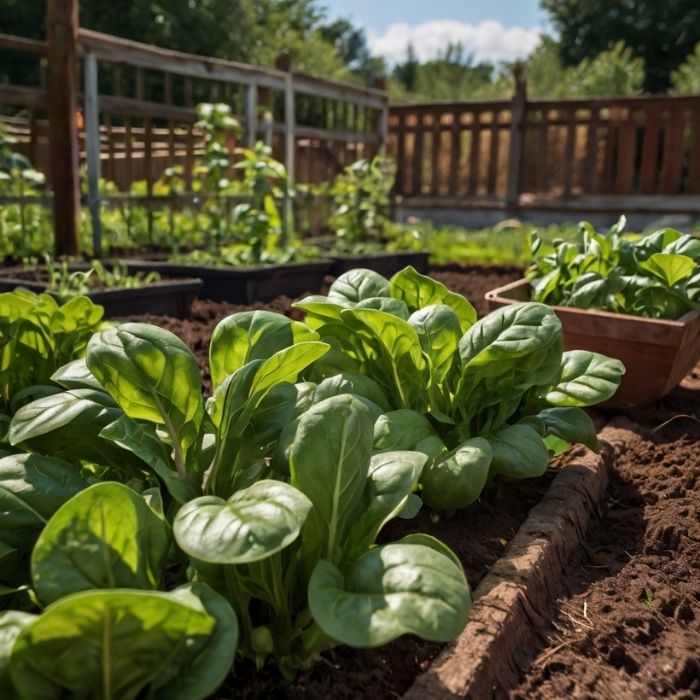Bloomsdale Spinach: A Gardener’s Favorite for Flavor and Resilience
Spinach is a staple in many home gardens, and among the wide variety of spinach types, Bloomsdale spinach stands out as a classic favorite. Known for its rich flavor, crinkled leaves, and impressive resilience, Savoy spinach has become a go-to choice for gardeners and cooks alike. In this article, we’ll explore the history, benefits, planting tips, and care guidelines for this remarkable leafy green.
The History of Bloomsdale Spinach
Bloomsdale spinach traces its roots back to the 19th century when it was developed by D.M. Ferry & Co., a seed company in Michigan. It quickly gained popularity for its robust growth, high yield, and delectable taste. Named after the Bloomsdale estate in Pennsylvania, this spinach variety was designed to thrive in a range of climates and soil types, making it a versatile option for gardeners everywhere.
Why Choose Bloomsdale Spinach?
1. Superior Flavor
One of the defining characteristics of Bloomsdale spinach is its sweet, earthy flavor. The leaves are tender yet sturdy, with a slightly nutty undertone that enhances salads, sautés, and smoothies.
2. High Nutritional Value
Bloomsdale spinach is a powerhouse of nutrients, rich in:
- Iron: Supports healthy blood cells and prevents anemia.
- Vitamins A and C: Boosts immunity and promotes glowing skin.
- Calcium: Strengthens bones and teeth.
- Antioxidants: Helps fight free radicals and reduces inflammation.
3. Cold Tolerance
Unlike many other spinach varieties, Bloomsdale spinach thrives in cooler temperatures, making it an excellent choice for early spring or fall planting. Its cold-hardiness allows it to withstand light frosts, extending the growing season.
4. Beautiful Appearance
The dark green, heavily savoyed (crinkled) leaves of Savoy spinach add visual appeal to your garden and plate. Its lush growth also makes it an attractive companion plant in vegetable beds.
How to Grow Bloomsdale Spinach
Growing Bloomsdale spinach is relatively straightforward, even for novice gardeners. Here’s a step-by-step guide to get you started:
1. Choose the Right Location
Spinach thrives in well-draining soil with a neutral pH of 6.0–7.5. Select a location that receives partial to full sunlight, although Bloomsdale spinach can tolerate some shade.
2. Prepare the Soil
Before planting, enrich the soil with organic compost or well-rotted manure to boost fertility. Savoy spinach prefers nutrient-rich soil that retains moisture without becoming waterlogged.
3. Planting Seeds
- Timing: Plant Savoy spinach seeds 4–6 weeks before the last frost date in spring or 6–8 weeks before the first frost in fall.
- Spacing: Sow seeds ½ inch deep and 2 inches apart in rows spaced 12 inches apart.
- Thinning: Once seedlings emerge, thin them to 4–6 inches apart to allow room for growth.
4. Watering
Keep the soil consistently moist but not soggy. Aim to provide 1–1.5 inches of water per week, either through rainfall or irrigation. Mulching around the plants can help retain soil moisture and regulate temperature.
Tips for Successful Bloomsdale Spinach Cultivation
- Succession Planting
To enjoy a continuous harvest, sow new seeds every two weeks during the growing season. This ensures a steady supply of fresh leaves for your kitchen. - Pest Control
While Bloomsdale spinach is relatively pest-resistant, common threats like aphids, leaf miners, and slugs can still cause damage. Use natural pest deterrents like neem oil or introduce beneficial insects like ladybugs to protect your plants. - Weed Management
Weeds compete with spinach for nutrients and water. Regularly remove weeds by hand or use a hoe to keep your garden beds tidy and spinach healthy. - Bolting Prevention
Savoy spinach is prone to bolting (flowering) in hot weather. To delay bolting:
- Choose a planting site with partial shade in warm climates.
- Provide consistent watering to reduce stress.
- Harvest leaves frequently to encourage new growth.
Harvesting Savoy spinach
Bloomsdale spinach is typically ready to harvest 40–50 days after planting. Here’s how to harvest it for the best results:
- Baby Leaves: For tender young leaves, begin harvesting when the plants are 3–4 inches tall.
- Mature Leaves: Wait until the plants are 6–8 inches tall for larger, more robust leaves.
- Cut-and-Come-Again Method: Harvest the outer leaves first, leaving the inner leaves to continue growing. This method allows for multiple harvests throughout the season.
Culinary Uses for Bloomsdale Spinach
Bloomsdale spinach is incredibly versatile in the kitchen. Its slightly sweet flavor and sturdy texture make it ideal for a variety of dishes:
- Fresh Salads: Pair with nuts, berries, and a tangy vinaigrette for a refreshing side dish.
- Smoothies: Blend with fruits and yogurt for a nutrient-packed breakfast.
- Sautés: Sauté with garlic and olive oil for a simple yet flavorful side.
- Soups and Stews: Add during the last few minutes of cooking for a nutrient boost.
- Pasta and Omelets: Incorporate into creamy sauces or egg dishes for added flavor and color.
Saving Bloomsdale Spinach Seeds
If you’d like to grow Bloomsdale spinach again next season, consider saving seeds from mature plants:
- Allow a few plants to bolt and produce flowers.
- Wait for the seeds to dry on the plant.
- Harvest the seeds, remove any debris, and store them in a cool, dry place for future planting.
Conclusion
Bloomsdale spinach is a standout choice for gardeners who value flavor, resilience, and ease of cultivation. Its rich history, nutritional benefits, and versatility make it a must-have addition to any vegetable garden. Whether you’re a seasoned gardener or a beginner, growing Savoy spinach is a rewarding experience that yields delicious results.
So, why not give Savoy spinach a try in your garden? With proper care and attention, you’ll enjoy a bountiful harvest of this beloved leafy green. Sweet Basil Seeds: Health Benefits, Uses, and Growing Tips

